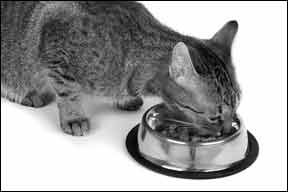Bringing out the nutritional best in your cat goes beyond the food in the bowl. Frequency of meals, location, post-meal bowl cleaning and other environmental factors also influence his health.

288
“One of the biggest problems is that far too many people overfeed their cats, and the cats become overweight and some even become obese,” says nutritionist Joseph Wakshlag, DVM, Ph.D., Associate Professor of Clinical Nutrition at Cornell University College of Veterinary Medicine. “Dogs give you those begging eyes when you sit down to eat, but in most cases, you can get them to go into another room and leave you alone.”
They excel at begging. “Cats, however, are aggressive beggars. They will keep purring and meowing. If you tell them to go away, they will just come right back and start meowing again. They are more persistent than dogs and far too often, the person gets frustrated and will get up and put more food in their bowls.”
Dr. Wakshlag recommends owners work closely with their veterinarians to select quality diets that have adequate protein for cats, who are obligate carnivores, or meat eaters. “There is some concern about grains in cat foods, but carbohydrates are necessary to make cost-effective foods and grains are inexpensive,” he says. “Cats do well on grains but not on all-grain diets. They don’t metabolize as quickly to absorb the glucose.”
To make mealtime more satisfying and safe for cats, Dr. Wakshlag offers this advice to improve their environment:
Provide mini-meals rather than one big meal. In general, cats are grazers, unlike dogs, who tend to be gorgers.
Mini-meals, say in the morning, when you return from work and before bedtime can also help maximize your cat’s metabolism.
Use a measuring cup. While suggested portions are often printed on the bags of dry and canned foods, Dr. Wakshlag says it’s vital to measure the food precisely and work with your veterinarian to establish daily portions that meet your cat’s age, health and activity.
Separate cats at meal times — especially if you have a feline food bully or a cat on a therapeutic diet. Meal times should be calm, welcoming events so cats can properly digest their food. Stress created by other cats in the household trying to steal another’s food can cause stress and possibly even gastrointestinal upset. Dr. Wakshlag recommends training the cats to eat in separate rooms where doors can be closed. “Cats like routine, and in time, they may even park themselves in front of their designated rooms at meal time waiting for you to feed them.”
Give the bowls a thorough soaking and cleaning after meals. They can be coated with salmonella. Dr. Wakshlag advises soaking them in a solution of one to two capfuls of bleach per gallon of water for 10 minutes minimally and then washing them in warm water with mild detergent. Thoroughly rinse and allow to air dry.
Resist buying gigantic bags of food. You’ll get more than you bargained for — increased risk of the food becoming stale and contaminated. Instead, Dr. Wakshlag suggests storing a small or medium-sized dry food bag inside an air-tight plastic food storage bin. “Emptying the food into a plastic container — even though it is air tight — can still cause food to go rancid. That’s because there are fats sprayed on the food and they line the inside of the container. If you don’t completely empty and clean the container before adding a new bag of food, it can cause the new food to go rancid quicker.”
Rinse the container, add the bleach solution and allow it to soak for 20 minutes, then rinse and dry it completely before adding a new batch of food. “If you just keep the food in the original bag and put it in the plastic bin, you don’t have to worry about cleaning the bin,” Dr. Wakshlag says. “Just throw the bag away.”
Pay heed to the contents of your floor-cleaning products. Dr. Wakshlag says cleaning products containing bleach are effective in killing viruses on the kitchen floor. However, cats have sensitive noses and some may be repelled by the odor of cleaners. He recommends not cleaning the floors immediately before meal times.
His final advice: “If you have two cats and one is more of a food bully to the other cat or to their owner, put some dry food in a food puzzle toy for this cat. This gives him something to do at meal time and he gets to burn a few extra calories hunting for his food.”


